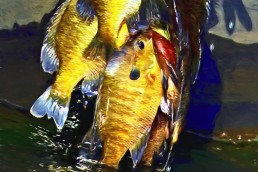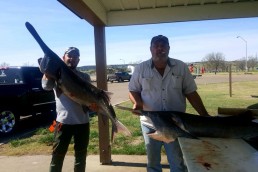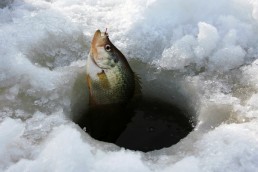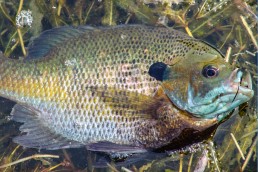SHARE THIS POST
You don’t need a big boat, expensive equipment or a fishing library in your head. Bluegill fishermen often carry flea market deals, a box of crickets or worms and a plastic bucket to the bank. The bucket provides not only something to sit on, but also a handy container for the catch.
I prefer artificial lures, and most of the time I do just fine. I imagine I’ve tried just about everything, and I tell you the Mepps’ little Spin Fly and Strike King’s Bitsy Minnow are both great for bluegills. Fishing a Spin Fly does require some degree of rod-handling skill. The hardest part is getting these little inline spinners to spin, and you’ve got to do that because they won’t catch a thing unless the spinner is whirling around the shaft.
After you deliver the cast, point the rod tip directly down the line, take up slack, and then crank the reel fast while violently wiggling the rod tip from side to side. It only takes two or a few quick cranks to get the lure spinning, then slow down gradually. Don’t pause or the spinner will stall. Once you get it spinning, the slower you go the more panfish you’ll catch. Try to crank it back just fast enough to keep the spinner revolving with a smooth, steady retrieve. Any bluegill within a yard of the thing can’t resist it.
You can get by with spinning equipment that handles 6-pound-test line, but 4-pound-test line casts these little baits farther and makes getting them to spin a little easier.
Mepps makes two sizes of the Spin Fly. I love the smallest one, an “Ultralight.” This is my favorite size because being smaller you can then retrieve it slower, which is always better for bluegills. My favorite color is Black, not so much because bluegills prefer the black. I think they’ll hit any color of this spinning lure, but I like black because big redear seem to prefer these.
Are you enjoying this post?
You can be among the first to get the latest info on where to go, what to use and how to use it!
Anyone, regardless of fishing prowess, can catch a great number of bluegills with Bitsy Minnows; all you do it cast it out and retrieve it slowly. Fish hook themselves on these, in fact, they often get all three rear trebles stuck inside their mouths so if you fish these be sure to carry a small pair of pliers or hemostat to remove the hooks. My favorite way is to fish with momentary pauses. Bitsy Minnows suspend when paused, and big bluegill thinks this is the perfect time to attack them.
Another favorite lure I’ve used a lot this year is Charlie Brewer’s Crappie Sliders. They’re not just for crappies, as these little Sliders at 1/16 ounce will catch everything, including bluegills. The difference is this “larger” bait handles well on 6-pound-test line and is completely weedless and great in brushy or weedy areas. Simply cast it out and bring it back very slowly and steadily, bumping the bottom. Don’t set the hook until you feel a steady resistance. Smaller bluegills will peck at it, but the larger (hand-sized) bluegills have no trouble getting the hook into their mouths. Truth is, you don’t really have to set the hook at all. Bluegills will hook themselves on Sliders if you just keep reeling until they make your rod throb.
For you fly fishermen, nothing beats a number 14 or16 fur ant cast on a 5-weight outfit with a 4X leader. In fact, I still believe this is the best way of all to fish for bluegills. If you can, buy or tie them slightly weighted. Sometimes, ‘gills hug the bottom, and when they are guarding nests (the best time to fish for them), they won’t move up off a nest to take anything. But when it gets anywhere near their nests, they’ll attack it.
Besides, the only way to catch redear is on the bottom. I’ve heard fly fishermen say that you can’t fly-fish for redear. If all you throw is poppers, this may be true. But I can assure you that if you sink a black fur ant to them they’ll take it in a heartbeat, and as a result, your heartbeat will go up.
MWO
SHARE THIS POST
Did you enjoy this post?
You can be among the first to get the latest info on where to go, what to use and how to use it!
MWO
We believe being outdoors is good. With more than 1,000 articles each year, MidWest Outdoors magazine is all about sharing outdoor experiences with you—where to go, what to use and how to use it… whether you’re close to home or on that trip of a lifetime.



